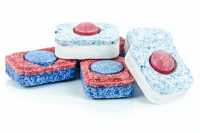
03 Jun Laundry Detergent Packets Still Poison Kids, Despite Tougher Standards
MedicalResearch.com Interview with:
Dr. Gary Smith, MD MPH
Director, Center for Injury Research and Policy
Nationwide Children’s Hospital
Columbus, OH
MedicalResearch.com: What is the background for this study? What are the main findings?
Response: Our 2016 study (https://pediatrics.aappublications.org/content/137/5/e20154529) investigated calls to US poison control centers related to laundry and dishwasher detergent exposures among children younger than 6 years old from 2013 through 2014 and found that poison control centers received more than 30 calls a day about children who had been exposed to a laundry detergent packet, which is about one call every 45 minutes.
The current study investigated trends in calls to poison control centers across the country for exposure to liquid laundry detergent packets in order to evaluate the impact of the voluntary safety standard for this product with a focus on young children. The study found only a modest decrease (18%) in calls for children younger than 6 years of age following adoption of a 2015 product safety standard as well as an increase in calls for older children and adults. Exposures to the eyes also continued to climb.
The observed decrease in exposures among young children is considerably less than the 40% to 55% decrease in toxic ingestions seen after passage of the Poison Prevention Packaging Act. This demonstrates that the current liquid laundry detergent safety standard is inadequate and needs to be strengthened.
MedicalResearch.com: What should readers take away from your report?
Response: This study investigated trends in calls to poison control centers across the country for exposure to liquid laundry detergent packets in order to evaluate the impact of the voluntary safety standard for this product with a focus on young children. The study found only a modest decrease (18%) in calls for children younger than 6 years of age following adoption of a 2015 product safety standard as well as an increase in calls for older children and adults. Exposures to the eyes also continued to climb.
The number of exposures remain unacceptably high. The current voluntary safety standard is inadequate and should be strengthened.
MedicalResearch.com: What recommendations do you have for future research as a result of this work?
Response: In the time it takes to move a shirt from the washer to the dryer, a child can ingest a dangerous dose of laundry detergent from a packet. This can happen to the best families – parents simply cannot watch their child every second of the day. Consumer products are generally developed by companies interested in making a profit, and unfortunately children’s safety is often an afterthought. Laundry detergent packets look like candy or food to a young child and were initially marketed in non-child-resistant containers. We have safer alternatives to laundry detergent packets – we’ve used them for decades. There’s absolutely no reason why we should see children being rushed to hospitals in coma, having seizures, or even dying due to this product.
Requiring that all liquid laundry detergent packet packaging be PPPA-compliant would be an important next step in reducing child access to these products (the current safety standard allows manufacturers to meet the child resistance requirement in six different ways). In addition, each liquid laundry detergent packet should be individually wrapped with child-resistant packaging, which would provide important layers of protection for this highly toxic product.
Liquid laundry detergent packets are more toxic than traditional liquid and powder laundry detergent. Further research is needed to determine how to make packet contents less toxic. Such reformulation would reduce the severity of exposures to liquid laundry detergent packets.
MedicalResearch.com: Is there anything else you would like to add?
Response: It is important not to accept the argument that the industry likes to make that the problem has been solved because the percentage decrease in exposures to liquid laundry detergent packets has been much greater when the number of exposures to detergent packets is compared with the number of packets sold. While the math may be correct, the logic is not correct. This is the equivalent of stating that we do not have a problem with Zika virus exposures because the size of the mosquito population increased much more in relation to the number of Zika virus exposures over time. For public health problems, we always focus on the population at risk and not on irrelevant numbers, such as the number of mosquitos or detergent packets sold.
I have no financial relationships or potential conflicts of interest relevant to this article to disclose.
Citation:
Safety Interventions and Liquid Laundry Detergent Packet Exposures
Christopher E. Gaw, Henry A. Spiller, Marcel J. Casavant, Thitphalak Chounthirath, Gary A. Smith
Pediatrics June 2019
https://pediatrics.aappublications.org/content/early/2019/05/31/peds.2018-3117
[wysija_form id=”3″]
[last-modified]
The information on MedicalResearch.com is provided for educational purposes only, and is in no way intended to diagnose, cure, or treat any medical or other condition. Always seek the advice of your physician or other qualified health and ask your doctor any questions you may have regarding a medical condition. In addition to all other limitations and disclaimers in this agreement, service provider and its third party providers disclaim any liability or loss in connection with the content provided on this website.
Last Updated on June 3, 2019 by Marie Benz MD FAAD

